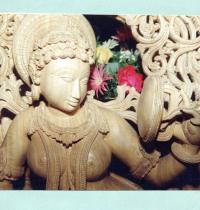T Pankajaksha
Arts Research and Documentation
2002-2003
Grant Period: Over one year
T Pankajaksha, hails from a family of sculptors has had his training in Bharadwaja Sculpture School and K.P.J. Prabhu Art School. Adept in both wood and stone carving, he has executed several prestigious sculptures including Herambha Ganapathi in Hattangadi, and majestic elephants in Dharmasthala.
Pankajaksha feels initiatives are needed to bridge gaps between the theoretical knowledge available in classical texts, the contemporary literature on the subject and the concerns of ordinary sculptors who form the backbone of the profession.
Outlining some key problems, he points out that Sanskrit classical texts Shilpasastras’, which expound on the principles and techniques of the art form, are inaccessible to ordinary sculptors who are mostly uneducated. Their interpretations are presently in the hands of Sanskrit scholars who proclaim that ambitious sculptors should go beyond the limits of the texts in the process of creation. However, sculptors are relying on individual experience and entangled in doubts and fears of going against the ‘sastras’ that are not known.
Lately, some good texts have emerged on traditional sculptures of south India. However, they are mostly in English and focus on the art historical. Again, sculptors working in the vernacular find it difficult to put them to practical use. There is still not enough material that explains aesthetic and stylistic differences between the schools.
He applied under IFA's arts and research and documentation programme with a hope that it could help him demarcate work between earning livelihood and cultivating creative faculties. Pankajaksha plans to undertake a research to prepare a sourcebook in simple Kannada that will be accessible to an ordinary traditional sculptor. The sourcebook will include an introduction to the texts of ‘Shilpasastras; a series of line-drawings illustrating aesthetic features of Chola, Chera, and Hoysala styles with supplementary explanatory notes and photographs; identification of geographical, ideological and historical aspects of each style; minute details of aesthetic features of key sculptures in different styles; and tips for creating new works within the confines of traditional aesthetic principles.
Pankajaksha feels initiatives are needed to bridge gaps between the theoretical knowledge available in classical texts, the contemporary literature on the subject and the concerns of ordinary sculptors who form the backbone of the profession.
Outlining some key problems, he points out that Sanskrit classical texts Shilpasastras’, which expound on the principles and techniques of the art form, are inaccessible to ordinary sculptors who are mostly uneducated. Their interpretations are presently in the hands of Sanskrit scholars who proclaim that ambitious sculptors should go beyond the limits of the texts in the process of creation. However, sculptors are relying on individual experience and entangled in doubts and fears of going against the ‘sastras’ that are not known.
Lately, some good texts have emerged on traditional sculptures of south India. However, they are mostly in English and focus on the art historical. Again, sculptors working in the vernacular find it difficult to put them to practical use. There is still not enough material that explains aesthetic and stylistic differences between the schools.
He applied under IFA's arts and research and documentation programme with a hope that it could help him demarcate work between earning livelihood and cultivating creative faculties. Pankajaksha plans to undertake a research to prepare a sourcebook in simple Kannada that will be accessible to an ordinary traditional sculptor. The sourcebook will include an introduction to the texts of ‘Shilpasastras; a series of line-drawings illustrating aesthetic features of Chola, Chera, and Hoysala styles with supplementary explanatory notes and photographs; identification of geographical, ideological and historical aspects of each style; minute details of aesthetic features of key sculptures in different styles; and tips for creating new works within the confines of traditional aesthetic principles.



